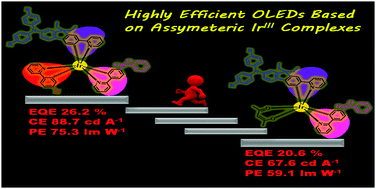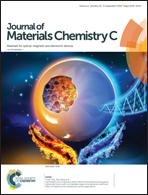Asymmetric tris-heteroleptic iridium(iii) complexes containing three different 2-phenylpyridine-type ligands: a new strategy for improving the electroluminescence ability of phosphorescent emitters†
Abstract
A series of asymmetric tris-heteroleptic Ir(III) phosphorescent complexes adopting both IrLL′L′′ (Ir3-1 and Ir3-2) and IrLL′(acac) (Ir2-1 and Ir2-2) chemical constitution have been successfully prepared, where L, L′ and L′′ represent different ppy-type (2-phenylpyridine) ligands. The IrLL′L′′ asymmetric tris-heteroleptic Ir(III) phosphorescent complexes Ir3-1 and Ir3-2 bearing three different ppy-type ligands can show better thermal stability, higher ΦP and improved ability of trapping both holes and electrons than IrLL′(acac) asymmetric analogs Ir2-1 and Ir2-2. Thanks to these advantages, Ir3-1 and Ir3-2, especially Ir3-2, can show phenomenal EL performance with a maximum external quantum efficiency (ηext) of 26.2%, a maximum current efficiency (ηL) of 88.7 cd A−1 and a maximum power efficiency (ηP) of 75.3 lm W−1, much higher than the data achieved by not only IrLL′(acac) asymmetric analogs Ir2-1 and Ir2-2, but also the traditional Ir(L)3 symmetric counterparts. To the best of our knowledge, these data represent the highest EL efficiencies ever achieved by the asymmetric ppy-type Ir(III) phosphorescent complexes reported in the literature. All these encouraging results not only indicate the great potential of the unique asymmetric IrLL′L′′ structures bearing three different ppy-type ligands in improving the EL ability of ppy-type Ir(III) phosphorescent emitters, but also represent important progress in the design and synthesis of new asymmetric ppy-type Ir(III) phosphorescent complexes with high EL ability.



 Please wait while we load your content...
Please wait while we load your content...